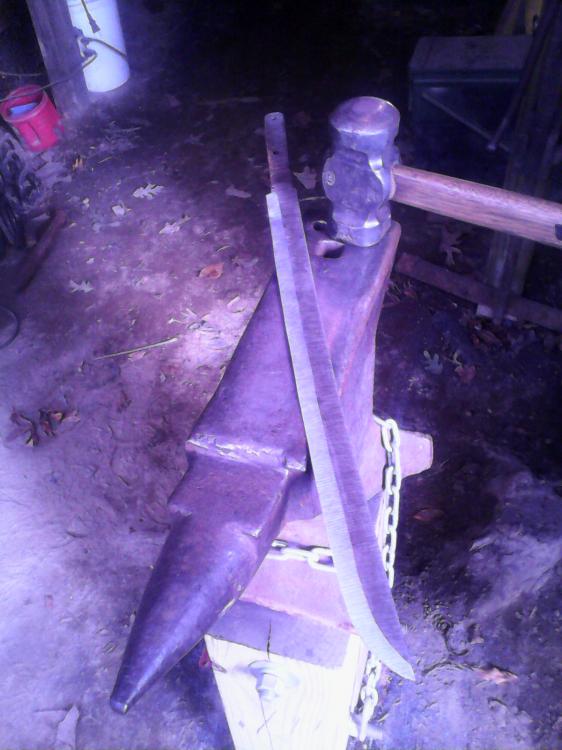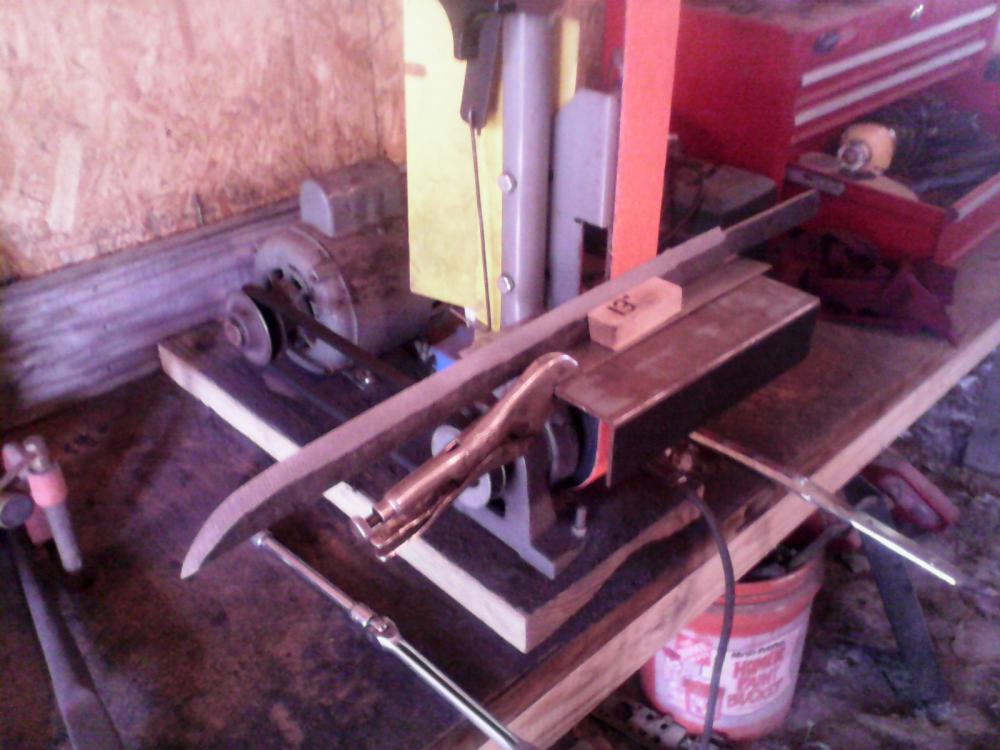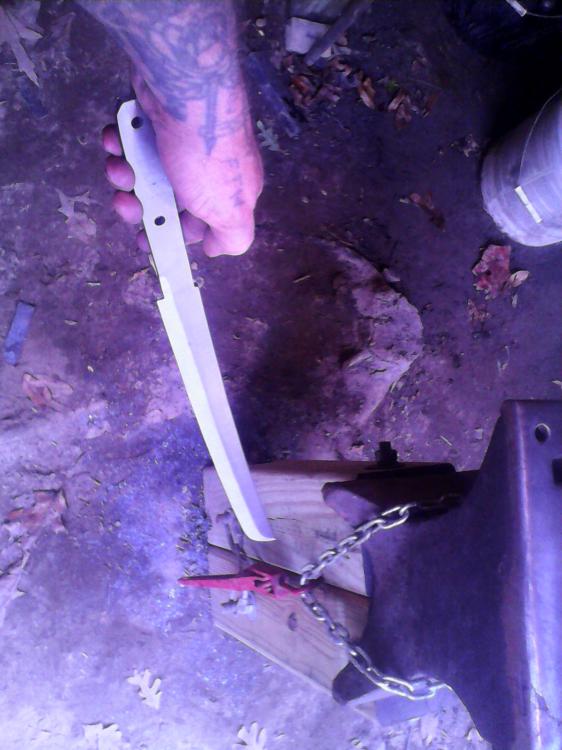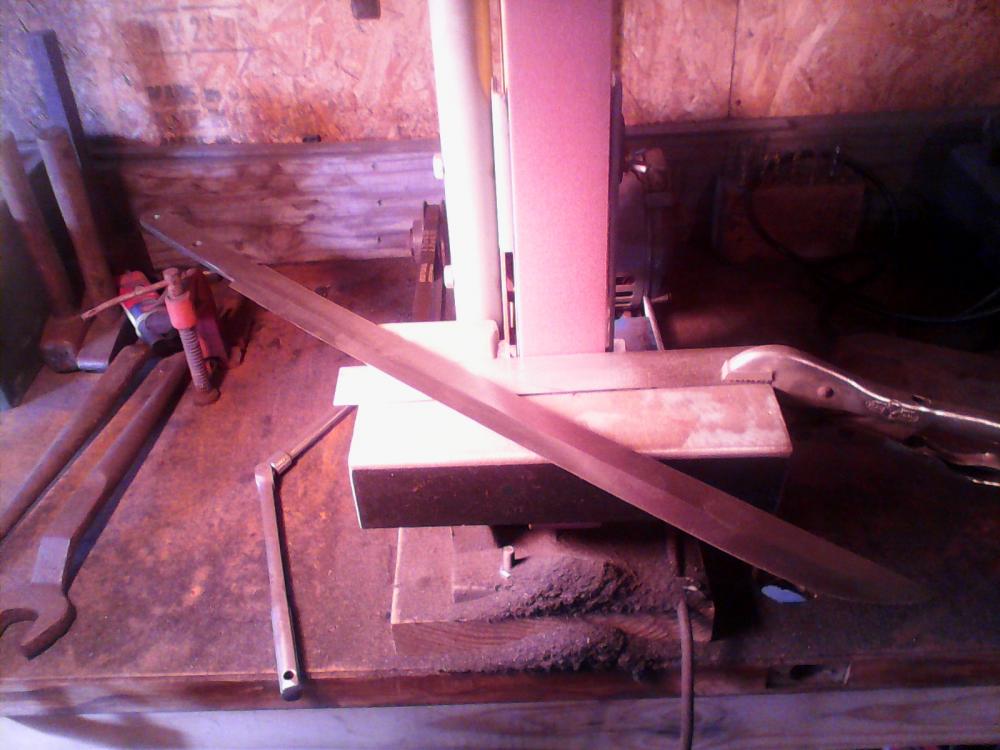-
Posts
450 -
Joined
-
Last visited
Content Type
Profiles
Forums
Articles
Gallery
Downloads
Events
Everything posted by TwistedCustoms
-
Awesome, looks great!
-
Last weekend a friend brought me replica ( junk/toy ) sword and asked if I could use it as a pattern and forge one for him. My buddy is into eastern martial arts and owns some nice Japanese swords so he does know that however this turns out it won't be "the real thing". I like a project as much as the next blacksmith so I said I would give it a go. For those of you who forge swords please keep the following in mind. I consider myself to be a blacksmith first, a knife maker second, and before today the largest blade I had ever forged was a 13" seax. I've made some Bowie's in the 12" range but no eastern style blades. Also, I have a great sense of humor and thick skin so feel free to tell me what I'm doing wrong. I ripped a 1" strip from the side of a 3/8" thick leaf spring 26" long and started forging from there. The edge bevel was ground using a 13° bevel block as a guide. I started with 36 grit, dropped to 150 grit and got to what a lot of manufacturers call a "satin" finish. The holes in the tang are pierced and the shoulders between blade and tang are in line, not offset like the toy blade I'm copying. My friend will be doing all the fitting and finishing on the handle so I'm not sure if that will matter to him. I'm going back to the shop after I post these pics to harden and temper. It will either shatter, warp, or turn out OK. Either way I'll post new pics and follow up info tomorrow.
-
Nice lines all around, I like it. What is the handle length?
-
170lb - Anvil or really nice shaped ASO?
TwistedCustoms replied to Tubularfab's topic in Anvils, Swage Blocks, and Mandrels
Looks just like my mousehole, not bad condition either. Unless there is a huge crack or weld hiding under the paint/rust I say go for it. Cast iron will have no rebound at all! It looks way to good to be a copy. -
Great work, keep it up!
-
Nice Fisher, nothing to "fix". Forge away!
-
Great job cliff rat. I really like the fuller on the spine of the tang, another layer of dimension to draw the eye. First class all the way!
- 14 replies
-
- shibuichi
- mammoth ivory
-
(and 1 more)
Tagged with:
-
Demos and other smiths
TwistedCustoms replied to Blackdot Rob's topic in Blacksmithing, General Discussion
SpankySmith, Michael here. I'm 44 and like to consider myself well read but sadly I had never heard of Heschel before your post. A quick search has me intrigued and I now have an updated reading list for the weekend. Thanks for that. As for the other....I love watching other smiths work. I believe I can learn something from everyone, no mater how young or old, regardless of their experience level. I don't demo often, maybe two or three times a year, but I like the idea of offering my five pound rounding hammer to the know-it-alls in the crowd. I'm fortunate to know quite a few talented blacksmiths and of course we all pop up at the same events. When one of those guys shows up where I'm demoing they sometimes engage the crowd on my behalf and I'm greatful for it. I can focus on my work while they provide a running commentary, but again, these are truly knowledgeable guys who I consider to be friends. -
I agree with Alan, the most significant variable you listed is "early 20s". You still have plenty of time to develope good habits. When you double your age, then add a few years on top of that, it's time to start fine tuning every advantage you can. What works for me striking is a heavy hammer, 12 to 20lbs, with a short hickory handle, approx 30 inch. With a handle that short I can get the 20lb above my head for full power strikes and good control. Whichever hand is highest up the handle should slide down the handle as you swing through so the moment of impact finds both hands touching, one attop the other right at the end of the handle. I've never used an 8lb for striking and I'm not fond of the 12. I want the weight of the hammer to be doing a lot of the work on the down stroke. Get some cordwood and a splitting wedge and practice your swing with the short handle hammer. It won't have the same feel as forging but you can practice your swing and get your hammer under control between striking sessions.
-
Very nice job, I like the improvising most of all. Self made tools add satisfaction to any build.
-
Need help on slotting a hawk handle
TwistedCustoms replied to jmccustomknives's topic in Axes, Hatchets, Hawks, Choppers, etc
Don't know how extensive your woodworking tool collection is but if I was going to do very many of those I would set up a small table-router with a jig. You could select a slightly undersize cutter and use small strips of sandpaper to finish-fit the slot. The router would make slotting pretty much instant, perfect and repeatable. -
Keep your chin up Charles. I've been there, lived it. I never should have survived my youth and I wouldn't have if not for a merciful God and a good family. Saying a prayer for you, Alex and Ava.
-
Hey Stan, I use coils from American made trucks, mostly for the diameter. 1/2 ton truck springs tend to be around 5/8" and bigger trucks have 3/4" springs. Those are a good volume of steel to make a knife blade. Car springs run approx 1/2" diameter. I don't think there is a big difference in the quality, they are just smaller. I make some of my tongs from car springs and some smaller knives too.
-
Very cool old stake anvil, portable, for driving into a stump. I read somewhere that loggers used to take them out to the woods for setting saw teeth and light forging. Just pound the stake down into a green stump and build a fire. Instant smithy.
-
Great stuff' loving the cleavers! Some blades look so intuitive you just know they will work. Makes me want to chop something!
-
My Work for the last few nights.
TwistedCustoms replied to scottyp74's topic in Blacksmithing, General Discussion
From the first photo it looks like you may have tempered your drift? If so you would be better off bringing it up to forging temp and slow cooling it. You don't want those tools hard. When you insert the drift in the eye and hammer down the cheeks you don't want the drift snapping. My hammer punches and drifts are all untempered and work just fine on hot steel. Driving a punch through a two inch round at forging temp would mess up any tempper you put in your punches anyway. If I'm seeing something that isn't there correct me. Looking good. The little ball pein hammers make good hot sets too. Grind a chisel bevel on it and handle it and use it with a soft backing plate on top of the anvil and you have another shop tool. If you make a hot set it will still split kindling but if you make a hatchet the thinner blade section won't hold up for hot cutting. Hot set = two tools in one. -
That little grinder is an evolutionary leap forward from my 3x21 floor sander. I'm using Norton Blaze 120 and I'm still on my first belt, (light grinding an approx 20 blades). My drive wheel is flat but there was a pea size inclusion in the surface of the wheel when the rubber was vulcanized. Its a little crater right in the center of the wheel. Where its located I doubt it would affect hollow grinding but only do flat and convex so no worries. I'm hoping to make a trip to Cow-town this winter, any advise for blacksmithing related events in the DFW area?
-
GottMitUns, I forge five of those at a time. A few weeks ago I purchased and set up a Kalamazoo 2x48 grinder sans motor. I set it up with a 1/2hp Dayton motor and I love it. I know its not the best knife grinder made but my blades are forge finish, hammer marks left on except for the bevel which is a convex. Anyway, the 2x48 has been a big time saver, knives go in the oven by 1pm instead of 3pm. Pop usually has the leather done for each batch by the following morning. We each get a lot of down time throughout but we manage to complete five a day.
-
Busy week so far. I'm playing hooky from the shop this morning hoping my arrows will be delivered today and sipping coffee so I thought I would put up some pics. The knives are forged from coil springs, 5/8" diameter. Forged, normalized, heated to non magnetic and quenched in automatic transmision fluid, tempered at 400f for one hour and rubed with vegatable oil. The sheaths are 6oz veg tan tooling leather made by my Pop. When dad retired he took over the leather work for me and he does a much better job than I ever did!
-
Much better on round two! Don't stop while you have momentum, make a pair every day for a month. You can never have to many tongs and the practice drawing out will cut your time down on every set you make. Great job and keep the pictures coming!
-
Great job! My first set of tongs took all day to forge and looked rough but every set gets better. I can have a working pair in about an hour now. 5/8" rebar is cheaper than dirt and makes good tongs, low carbon will keep them from getting brittle quenching. The RR spikes should be good tong metal too. Keep it up and show us your next pair.
-
The anvil pictured is as good as the day it was made! Anything you do to it other than forging on it will destroy it. No mills, no grinders, no torches, no welders!!! Heat up some steel and start hammering, you have a treasure, dont ruin it!
-
Punch first, then drift to size. I use a long taper drift to draw the cheeks down, there isnt a lot of material to work with on a 5/8" square but you can draw them down a little. Next I used a guillotine fuller just as you said. You can also use a spring fuller or even top and bottom fullers if you have someone to strike for you. I hammer the blade into a fishtail and do a little grinding to finnish. If you plan to forge weld a high carbon bit in for a blade you will need to upset and slit the socket before you punch and drift the eye.
-
what can I do with these?
TwistedCustoms replied to possum's topic in Blacksmithing, General Discussion
Even if the taps and dies are too far gone to cut, which is doubtful, they can still be used to clean out rusted threads on machines or other things you may scrounge. They just need a shot of oil. The mill bed would make an awsome gig table with moveable pins for bending scrolls, holding work so you can really push on a hand held drill motor, all sorts of things. -
Thanks Norrin_Radd! I make a lot of these with 5-7" blades. This one was a fun project. Be sure to post photos when you're done!




